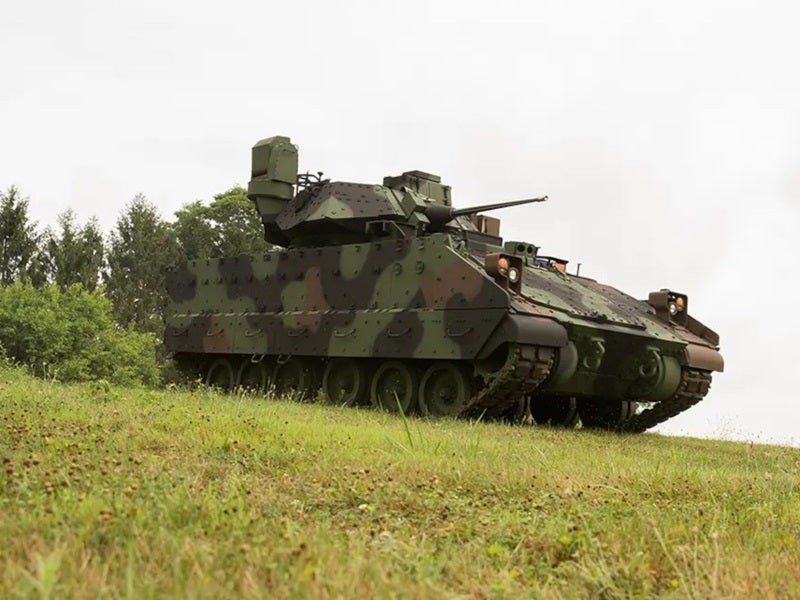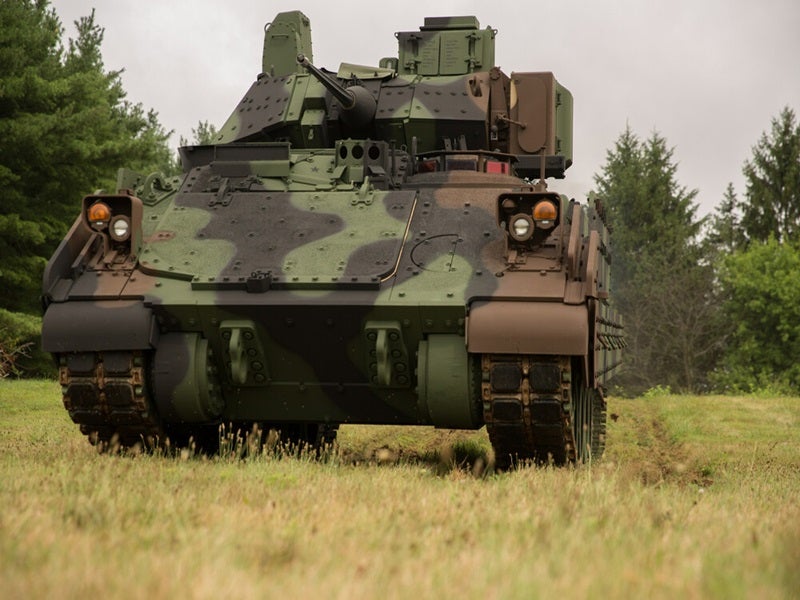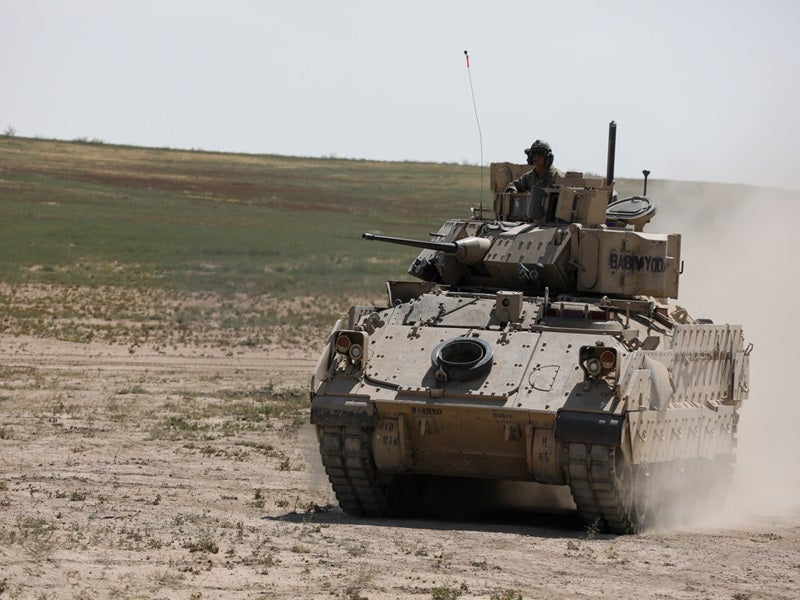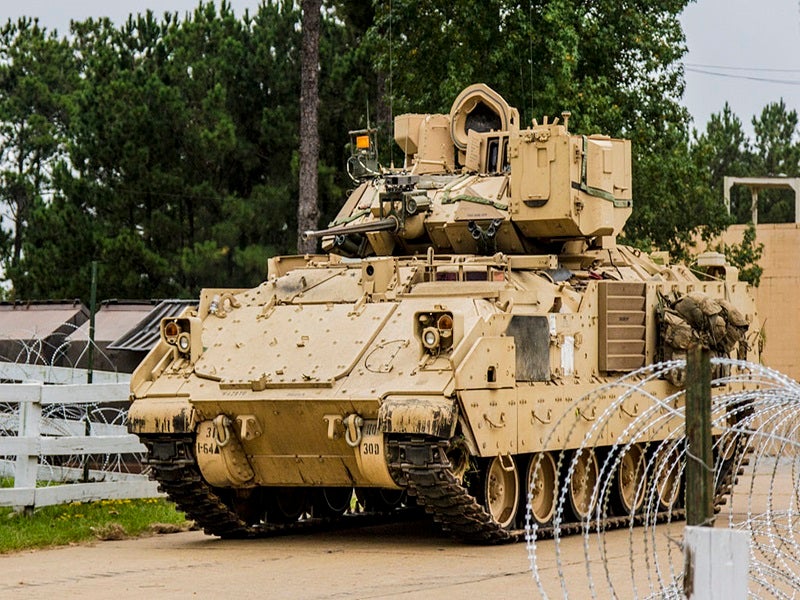The Bradley armoured fighting vehicle is manufactured by BAE Systems Land & Armaments (formerly United Defence), a subsidiary of BAE Systems.
The Bradley is available in two versions, including the M2 infantry fighting vehicle and the M3 cavalry fighting vehicle.
The vehicle is in service with the US and Saudi Arabian armies. Since 1981, a total of 6,720 vehicles of both types have been fielded.
The Bradley A4, an upgraded model currently in production, is built for durability and consistency to reduce logistical challenges.
It also improves battlefield performance to address diverse mission requirements, whether in close-combat, urban, or open-combat scenarios.
In September 2024, the US Army and BAE Systems finalised a $440m contract to produce more Bradley fighting vehicles.
The award covers the production of more than 200 A4 variants, which will be delivered to the US Army as modernised replacements for some of the Bradleys supplied by the US to Ukraine.
Bradley M2A3/M3A3 design and features
The Bradley fighting vehicle measures 6.55m in length, 3.61m in width, and 2.56m in height.
The role of the M2 infantry fighting vehicle is to transport infantry on the battlefield, provide fire cover to dismounted troops, and suppress enemy tanks and fighting vehicles.
The M2 carries a commander, gunner and driver, plus six fully equipped infantrymen while the M3 performs scout missions and carries three crew plus two scouts.
All Bradleys are amphibious. Earlier models are equipped with a water barrier that the crew fits before entering the water.
A3 models have an inflatable pontoon that attaches to the front and sides of the vehicle.
Performance and propulsion
The Bradley is equipped with a VTA-903T engine from Cummins Engine Co of Colombus, Indiana.
The hydromechanical transmission HMPT-500 from Combat Propulsion Systems, a Division of L-3 Communications, provides three-speed ranges. The engines provide a maximum speed of 66km/h.
Water propulsion is provided by the tracks, and the Bradley can attain a maximum speed of 7.2km/h in water. The Bradley fighting vehicle has a range of 483km.
Bradley urban survivability kit
Under a contract awarded in January 2008, BAE Systems supplied 952 Bradley urban survivability kits (BUSK).
The BUSK includes a high-powered, hand-held directional spotlight, sight protection for the turret’s external optics (consisting of a mesh encased in a steel frame) and a lightweight, non-conductive ‘dome tent’ structure to protect the turret and crew from low-hanging electrical power lines.
A commander’s light automatic weapon, a 5.56mm light machine gun integrated with the A3 fire control system and fired from within the armour, is under development for the BUSK. Additional armour to counter the effects of mines and improvised explosive devices (IED) is also installed
Syracuse Research Corporation supplied CREW-2 electronic warfare systems for 1,691 Bradley vehicles. The CREW-2 system is designed to jam remotely controlled IEDs, preventing the detonation of roadside bombs.
Under contracts placed in October 2008, BUSK also included fire detection/suppression systems, as well as advanced survivability seats.
FBCB2
In June 2004, DRS Technologies was awarded a contract to provide systems, including rugged applique computers, for the M2A3 Bradley and M1A2 Abrams tanks as part of the US Army’s Force XXI battle command, brigade and below (FBCB2) programme.
FBCB2 is a digital battle command information system, which provides enhanced interoperability and situation awareness from brigade to individual soldiers.
It will be used in conjunction with the Army’s tactical internet.
Fire control and observation
The gunner is equipped with a Raytheon integrated sight unit, which includes a day/thermal sight of magnification ×4 and ×12. An optical relay provides the image of the gunner’s sight to the commander.
The gunner also has periscopes for forward and side observation. A daytime sight system for the gunner or commander is provided as a backup to the primary sight.
The driver is equipped with three forward periscopes and one periscope to the left. The central periscope can be replaced with the Northrop Grumman (formerly Litton) AN/VVS-2 driver’s night viewer, which features a 25mm second-generation image intensifier.
Upgraded M2 Bradleys are equipped with the DRS Technologies driver’s vision enhancer.
Armament of Bradley M2/M3
The main armament is an ATK Ammunition Systems (formerly Boeing Ordnance) 25mm M242 Bushmaster chain gun. The M242 features a single barrel with an integrated dual feed mechanism and remote feed selection.
The gunner can select single or multiple-shot modes. The standard rate of fire is 200 rounds per minute, but the gun can be optionally converted to 500 rounds per minute. An M240C 7.62mm machine gun is mounted coaxially to the right of the Bushmaster.
The M2 Bradley is equipped with the Raytheon TOW BGM-71 anti-tank missile system. The twin-tube TOW launcher is mounted on the left of the turret. The target is tracked using an optical sight, which detects the infrared signal from the back of the missile in flight.
A double-wire command link between the missile and the gunner is dispensed from two spools at the rear of the missile. The launcher sends flight correction data to the guidance system on the missile via the command link. The range of the TOW missile is 3.75km.
Bradley M2/M3 self-protection
The Bradley is equipped with two M257 smoke grenade dischargers, each loaded with four smoke grenades. It is also fitted with an engine smoke-generating system.
The hull of the M2 Bradley is constructed of welded aluminium and spaced laminate armour. In addition, the M2A2/M3A2 Bradleys are equipped with applique steel armour and have provisions for additional passive armour or explosive reactive armour (ERA).
General Dynamics Armament and Technical Products developed an enhanced-capability reactive armour package for the Bradley. A total of 150 sets were delivered, and a follow-on contract for 168 sets was placed in July 2005.
Rafael Armament Development Authority, Ordnance Systems, of Haifa, Israel, is responsible for 50% of the production.
The ERA consists of 96 tiles fixed to the sides, turret, and front of the vehicle, enhancing protection against a variety of anti-armour munitions, including shoulder-launched rocket propelled grenades.
In September 2008, BAE Systems was awarded a contract to install IED mine armour on 433 Bradley M2/M3 vehicles. Under a $62m contract placed in April 2011, the vehicles are fitted with energy-absorbing seats, laser designation and other survivability systems.
Bradley M2A3/M3A3 upgrade programme
The US Army’s A3 Bradley upgrade programme includes improvements based on operational experience from the Gulf War. The first low-rate initial production M2A3/M3A3 Bradley was delivered in November 1998 and entered service in April 2000.
The system was approved for full-rate production in May 2001.
The upgrade of 120 vehicles (80 M2A3, 29 M3A3 and 11 A3 BFIST fire support) was ordered in February 2005, and in June 2005, a contract for the upgrade of an additional 450 vehicles to A3 standard was placed.
In August 2006, a follow-up contract was awarded for 96 vehicles (57 M2A3, 16 A3 BFIST and 22 A2 ODS BFIST) followed by another contract in November 2006 for 610 vehicles (490 A3 and 120 A2ODS). In July 2007, a further 172 vehicles (108 A2, 60 A3, four BFIST) were contracted.
The US Army’s requirement is for 2,545 upgraded Bradley A3 vehicles.
The upgrade included the improved Bradley acquisition system for the TOW missile from DRS Technologies and the commander’s independent thermal viewer from Raytheon, both of which use second-generation thermal imagers derived from the US Army’s horizontal technology initiative.
In October 2010, BAE Systems was awarded a $91m contract to replace the old and damaged systems in 552 Bradley vehicles for the US Army.
The US Army placed a $250m contract in November 2010 to procure long-lead items for 247 Bradley Operation Desert Storm Situational Awareness (ODS-SA) vehicle conversion kits.
A total of 202 kits were used to convert Bradley ODS vehicles to the Bradley ODS-SA configuration and the remaining will be retained for future vehicle conversions.
BAE Systems received a $47m contract to update 95 Bradley vehicles with new equipment and technology in February 2011.
A further $270m contract was awarded for the conversion of 245 ODS-SA vehicles in October 2011.
In October 2022, BAE Systems received a five-year, $383m contract from the US Army to perform technical and sustainment support services for its fleet of Bradley fighting vehicles and M993 multiple launch rocket system carriers.
The company is collaborating with the US Army to upgrade the Bradley to the A4 standard. It features all the enhancements of the A4 variant, along with an active protection system, an improved gunner sight, and a more efficient air conditioning system.
BAE Systems secured a contract modification worth more than $190m to continue producing the Bradley A4 in August 2023. The award includes more than 70 M2A4 infantry fighting vehicles and M7A4 fire support team vehicles.
In September 2023, the US Army awarded a $274.1m contract to convert existing vehicles into 109 M2A4 Bradley fighting vehicles and six M7A4 Bradley fire support team vehicles.






